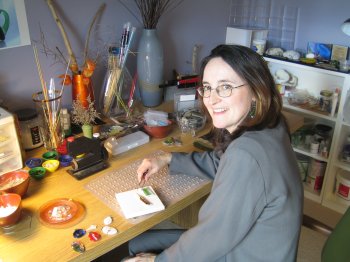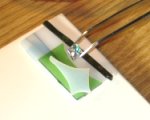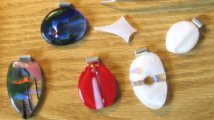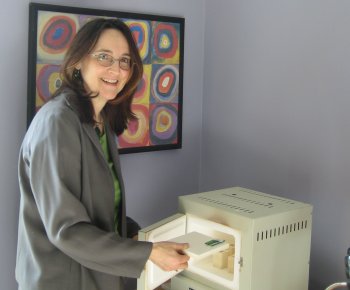- By Dan Veaner
- Business Profiles
 Print
Print  PAMA DesignsAll visual media use light, but art glass uses it more than others, and is transformed as light is applied. Glass jewelry takes on this dynamic quality even more as the person wearing it moves from place to place. And when the pieces are very beautiful, the effect is almost magical. "I have always really liked glass," says Lansing Village artist Alice Horrigan. "I like the way it looks. I ran into some nice art glass jewelry at the Grassroots Festival and I fell in love with this dichroic glass."
PAMA DesignsAll visual media use light, but art glass uses it more than others, and is transformed as light is applied. Glass jewelry takes on this dynamic quality even more as the person wearing it moves from place to place. And when the pieces are very beautiful, the effect is almost magical. "I have always really liked glass," says Lansing Village artist Alice Horrigan. "I like the way it looks. I ran into some nice art glass jewelry at the Grassroots Festival and I fell in love with this dichroic glass."Most artists can make art, but aren't as good at selling it. Horrigan stands out because in addition to producing beautiful work she is developing a wholesale business to sell it. Currently she is developing five lines of glass pendants and earrings that she can market to gift shops through her business, PAMA Designs. She decided to make the business full time last May, and has already begun finding shops to sell her work. She was recently invited to be one of the wholesalers to show at the American Craft Retailers Expo in Las Vegas next May.
Horrigan says that she views herself as part of an artisan class in America, and sees participating in growing her industry as part of her overall plan. "All of the tools we have now to make things now that have gotten the cost of getting into the market down," she says. "You can present yourself in a professional way and have the production capacity too to fill the gift ware shelves in the same way as other larger companies do. I see myself as participating in that and as also helping to forge the path for micro-enterprises."

Alice Horrigan
The last piece of the puzzle is the lifestyle element. Horrigan is faced with the same challenge that other well educated Ithacans face, who want to stay in the area, but compete for the few jobs in their field. More and more people are 'making a job' rather than finding one, and in doing so they tailor it to their lives. After careers in journalism and technical writing for IBM, she was ready to strike out on her own. "I am a single mother," she explains. "For me to go out to work all day every day full time would really impact on my ability to do a good job of parenting. That's an important segment of the economy that is populated in a rather large way by women, and by women who may not otherwise be able to make a decent living because of their geographical location or their life situation."
Horrigan credits the Internet for making it possible to create her business. After discovering the medium she found information about it on the Internet, instructions on how to work with the glass, information on tools and marketing. "I discovered you could actually purchase small scale kilns for fairly low price," she says. "There is a lot of information on the web on how to work with this glass to melt it and to layer it. There is all sorts of information and you don't have to take an expensive course or anything, so I decided to start working on it and I really liked it."
She still does odd jobs including elder care, writing, and even weeding for her landscape architect sister to make ends meet, but she chooses them to allow her the time she needs to be with her eight year old daughter and grow her business. "It's not easy to make a good living around here, so for me the micro-enterprise and being able to be global while you're very local, physically local, that's amazing, she says."


Pieces of dichroic glass are arranged on a kiln shelf to be melted together (left)
and some finished pendants (right)
Dichroic glass is a space-age product which has more than one color. Metallic oxides are applied to the glass in a high temperature, vacuum furnace. When you move the glass around the colors seem to change, something like a wiggle-picture. Horrigan takes pieces of this glass and arranges it to her own design specifications on a kiln shelf, where it is heated for three hours. When it comes out of the kiln it has melted into a single piece with streaks of color running through it. After seven hours of cooling, she finishes each piece on a grinder to get the exact shape she wants.
Horrigan takes her inspiration from her surroundings. Her Web site says she is inspired by the colors, shapes, and vines of the Finger Lakes, and you can see this in her work. This local quality is something she capitalizes on, as California does with wine or Florida with orange juice. Part of her plan includes approaching local winery organizations, to get local art craft into their gift shops. This makes sense because they, like the wine, are local products.
While she does not see retail as the thrust of her business she occasionally sets up shop at craft shows. She says that allows her to see who wants to buy her work, which helps identify her market. "Some people probably liked a little more conservative (product) like country craft stuff," she notes. "They weren't really my market at all. My market is more of the educated professional, more liberal and worldly. They want to buy glass for the contemporary design and the art in it. They aren't really looking to buy jewelry just for value."

The kiln is surprisingly small, but perfect for Alice Horrigan's home studio
She also holds occasional sales in her home. Last weekend she held her first annual holiday sale, again using the Internet to send e-mail invitations to potential customers. A flyer with pictures of the pieces was attached to the mail, saying that more than 50 pieces were available from all five collections. "All pendants come with a stainless steel choker, gift card, care card, and and light green tissue paper in a translucent frosted bag. Part of my proceeds go to the Craft Emergency Relief Fund."
An ongoing learning experience, Horrigan is also focussed on every aspect of her business, even developing talking points for interviews with the press. Meanwhile she is enjoying learning about tools and the technical side of her art, as well as creating the pieces themselves. She says she never envisioned herself owning a drill press, but now it has become an interest. "To me that's fascinating to learn how they attach the diamond to the drill bit and how fast it wears out."
But when it comes down to it, you can't market a product unless you have one. Horrigan says she enjoys the creative process as much as the technical and business parts. "There's the Zen of it where you're trying to calm down while you're doing it." And the results speak beautifully for themselves.
----
v2i48



